Sportboat Buying Check Points No. 5: What Hull Shape is Best?
When comparing sportboats, don't forget to look under the waterline: While most modern boats ride on some derivative of the V-hull, small differences in design can make a big difference in how well the boat suits your needs. Hull shape will affect top-end speed, wake size, fuel efficiency, relative dryness of the boat, and riding comfort. If you want a boat that fits you to a T, take some time to inspect her bottom.
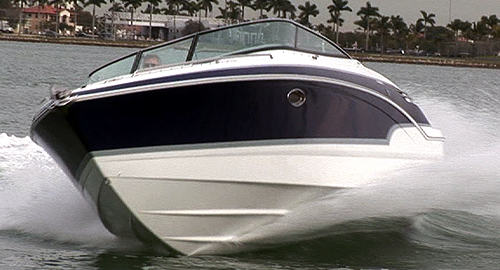 Here's a modern V-bottom in action; see how the strakes both deflect water to keep the crew dry, help prevent the hull from sliding in hard turns, and provide lift for faster planing speeds. The boat is a Formula 290 Bowrider. |
Check Point #5: Hull Configuration:
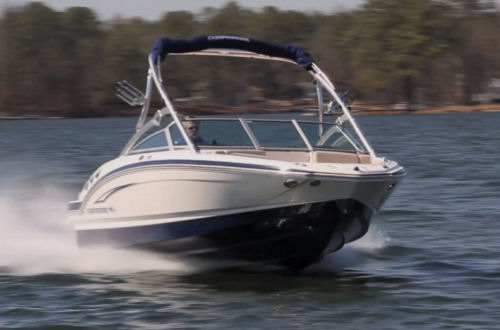 Most sportboats can go relatively fast, but the shape of the hull will determine how fast, how dry, how fuel efficient, and how comfortable the boat will be. |
A. What's the Intended Use -- And Where?
When considering what sort of hull is best for an intended application, remember that most sportboats were designed for lakes, rivers and protected water where waves are usually relatively small. That means that their freeboard might be relatively low and that the boat’s bottom shape might be a moderate or low deadrise.
Today, more and more boaters are using their sportboats in coastal waters, in sounds, estuaries, and large bodies of unprotected water where waves can be higher. But even on lakes and rivers with a long fetch, waves can build, and what is more fun than blasting over them at top speed?
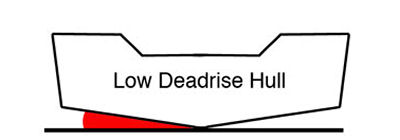 Low deadrise is typically considered to be from 5 to 13 degrees. |
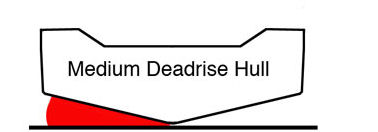 Medium deadrise in sportboats ranges from 14 to 18 degrees. |
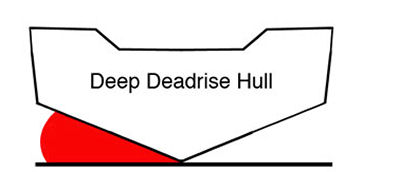 Deep deadrise is generally considered to be from 19 to 24 degrees. |
B. Pick The Deadrise Angle
Builders usually publish their deadrise angle at the transom. Most sportboats have "warped" hulls, with a sharper deadrise forward, a number that is rarely given. Smart boat buyers try to match the deadrise angle of the boat to the conditions they will be boating in as well as match it to the way they will be boating. For example, when sportboats on small lakes jump over waves they usually land stern first, and in that case a deep-V bottom aft will be more comfortable. Deeper-V bottoms for sportboats in big water is a given.
However, many boaters use their sportboats for tubing or waterskiing at 20 to 25 mph in smooth water, where a minimum wake is desirable and freeboard is not so important. In this case, a flatter bottom boat will be more desirable. The most important thing in choosing a hull is to match it to your intended use.
(As noted, most sportboats these days are variations on the V-hull theme. To find out more about the origin of the deep-V hull, click here... )
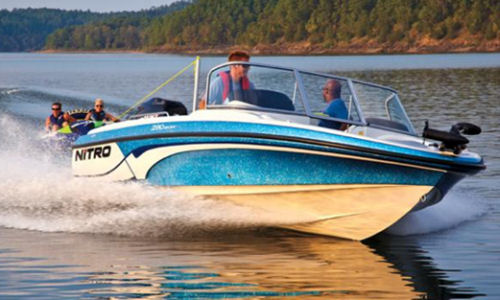 Nitro's multi-purpose 290 rides on 18 degrees of aft deadrise, a balance between comfort for family boating, wake generation for tubing and boarding and stability for fishing. |
B. Variations In Bottom Shape
In addition to the height of freeboard and depth of the deadrise noted above, there are other distinguishing features, such as “steps,” “pads,” “strakes,” “reverse chines,” and “split chines,” among other things. Each of these design elements are intended to improve some aspect of performance or utility, but do not expect any magic bullets.
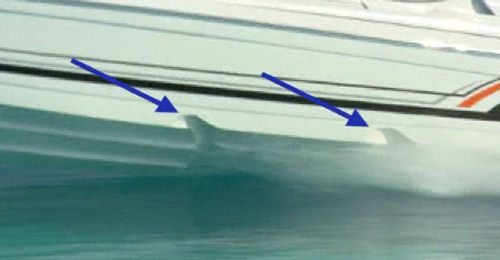 This boat has two steps in its hull, both of which might add a knot or so to its top speed. |
Steps: A stepped hull is one that has a deep groove molded into its hull that ventilates at the chine amidships. Some larger sportboats might even have two of them. The concept of the step is to suck air into a groove across the boat's bottom and thereby reduce wetted surface and provide a cushion of air under the bottom, making the boat go faster. Most builders claim that a step will add 1 to 1-1/2 knots to WOT speed. At normal cruising speed a step may make the hull slightly more fuel efficient, but any enhancement is probably nominal.
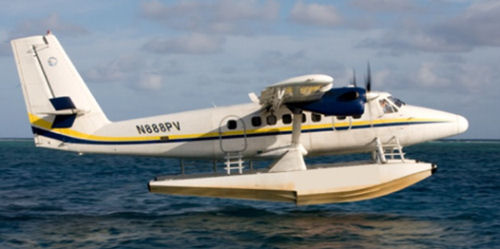 The steps on this seaplane's floats are there for the same reason they put them on boats: To reduce drag and boost speed vs. horsepower, both important factors in taking off from the water. FYI -- the deadrise on the floats is 24-degrees, and has been that way since the 1920s. (Photo: Seaborne Airlines) |
Steps are an old technique made new again. In the 1920s, raceboat builders used steps frequently, sometimes even cross-planking their boats' bottoms, overlapping the plank edges in lapstrake fashion to create dozens of mini-steps. This was very effective at increasing speed, often at the expense of handling, and eventually steps were outlawed for most organized racing.
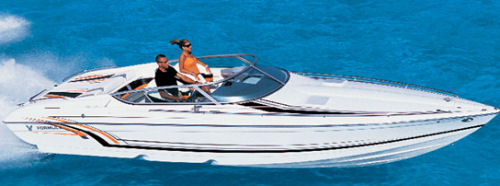 Formula adds two steps to their 292 FASTech bottom. Whether to use one step or two depends on the designer's preference and performance goals. Deadrise aft is 24 degrees. |
In the mid-1990s steps reappeared, on raceboats first, then pleasure boats, and now they are used on some sportboat models. Nevertheless, steps are tricky to design properly; if they're not done right, they can make handling unpredictable in certain conditions. We recommend buying a stepped hull only from a builder with an excellent reputation and/or on a model that has been tested by BoatTEST.com, as we are careful to make sure stepped hulls handle as they should.
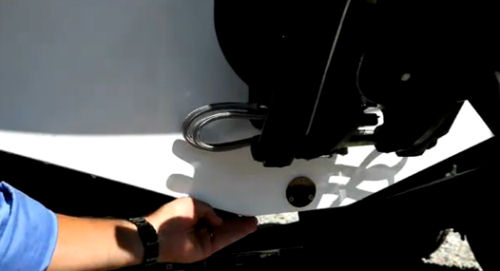 This 21’ sportboat has a pad on the keel that is about 7” wide at the transom. |
Pads: A pad is flat area on the keel of a boat that interrupts the deadrise. The pad may be anywhere from a couple of inches to as much as a foot wide, depending on the size of the boat. The pad extends forward from the transom some distance, but usually not more than a third of the hull length. Pads reduce wetted surface and provide an optimum planing surface for lift.
Pads are intended to make the boat faster at WOT, burn less fuel at normal planing speed, and allow the boat to get onto plane faster. BoatTEST.com has found that sufficiently large pads usually fulfill the intended promise.
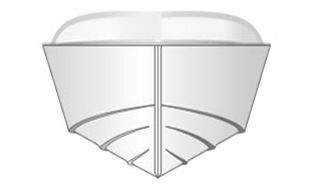 This boat has two running strakes on each side of the boat starting at nearly the stem. |
Strakes: Since the beginning of the deep-V era running strakes have been used to add lift to an otherwise hard-to-plane hull, as well as to knock down spray forward. Strakes are longitudinal and may start at any point from the boat’s stem on aft. Deeper-V hulls usually have more strakes than a lower deadrise hull, and low deadrise hulls might not have any strakes at all, nor need them.
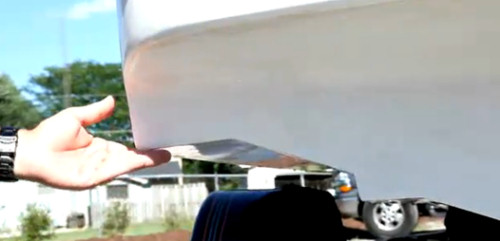 This 21’ sportboat has a wide reverse chine at the transom. Look carefully and you will see a slight down angle in the chine flat which will throw spray out and down. |
Reverse Chines: When runabouts were made of wood most had rounded chines. With the advent of fiberglass in the mid-1960s sportboats began to have angular chines simply because it was easier and cheaper to make a plug out of plywood with sharp angles.
With time “hard” chines developed which had a 90-degree angle where the hull side met the bottom. The bottom usually intersected the chine flat 1” to 9” from the hull side creating another lifting surface if it was under the waterline. The chine flat is relatively narrow forward and often widens as it moves aft. This design has the added advantage of resisting roll and defecting spray better than boats without it.
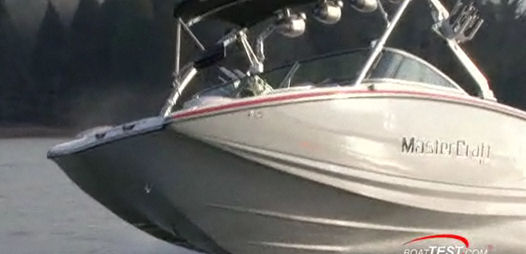 This pickle fork/split chine design provides more room in the bow seating area. Note that its port chine reaches up to the port side of the deck in the bow and that both chines are “split” from the stem of the boat which rises on the centerline. |
Split Chines/Pickle Fork: During the last several years a number of builders have introduced what is known as a “pickle fork” bow. The pickle fork bow was popularized in the 1960s in outboard raceboats around the world which ran on dual-hull sponsons. Sportboat builders have borrowed from the concept to widen the bow on deck so as to enlarge the sitting area of bowriders. Instead of the port and starboard chines meeting at the stem of the boat they extend up to the deck, meeting it at the port and starboard "tongs" of the pickle fork. For this reason, some builders call it a “split chine” design.
These designs do indeed provide more sitting space forward, as well as allowing more deck space and a larger anchor locker. Because the foredeck is larger, there is more room for a beach boarding ladder on some models.
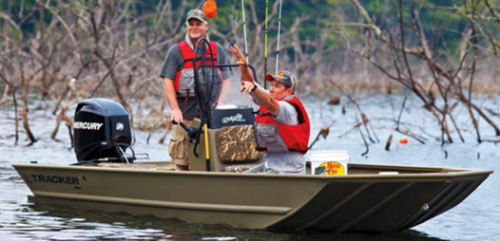 Don't expect this bluff-bowed, flat-bottom (3 degrees deadrise) Tracker Grizzly 1860CC to be very smooth-running in choppy waters – but that's not what she's designed for. For fishing and hunting in sheltered water, she's hard to beat. It's all a matter of matching boat and usage. |
C. Sharp Entry is Critical
Boats with sharper entries at the bow will generally pound less than those with fuller, more buoyant bow sections. But too sharp and/or too deep a bow can make the boat dig in and go through the waves rather than over them, as well as making the boat harder to steer.
Deadrise in the bow is almost never listed in the builders' specs, so you'll have to measure it yourself – a good excuse to visit a lot of boat dealers!
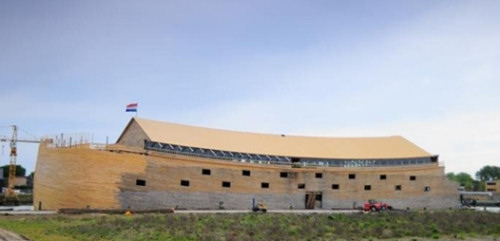 Sometimes you need lots of freeboard, like when you're carrying giraffes. But don't overdo it. This replica of Noah's Ark is on display in Holland; her builder is Johan Huibers. (Photo: www.arkvannoach.com) |
D. Freeboard Keeps You Safer and Drier
All other things being equal, the more freeboard a boat has the deeper can be its cockpit and the dryer it will be in windy conditions. Since low-freeboard, low-deadrise boats have less material in them, generally, they tend to be lighter and less expensive than sportboats intended to also be used on larger bodies of water, which have higher freeboards.
Again, match the hull to your intended boating conditions, and keep all things in moderation.
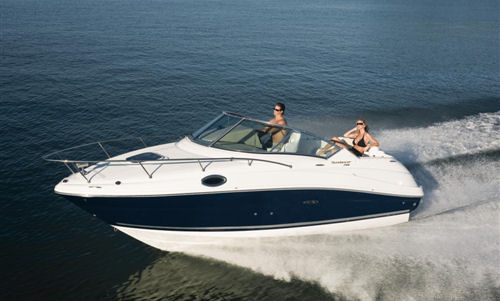 This Sea Ray 240 Sundancer has 18 degrees of deadrise, but she also has a fully enclosed head and a basic galley. Both are more important to your enjoyment than a little more, or less, deadrise. |
A Caveat -- Proper Perspective
Boat builders and dealers try hard to differentiate their brands. Design devices in the hull are aspects of differentiation. However, it is important to keep their benefits in perspective and weigh them against other aspects of the boats being considered which might be far more important.
While aft deadrise is probably the most important factor when comparing two similar modified-V hulls, don't over-focus on it. If one boat suits your needs better, but doesn't have what you consider the perfect deadrise, choose it anyway. You'll find that, for most people, deadrise isn't as important as cockpit layout, speed, accommodations and other factors.
A comfortable head compartment, or seating for eight people, or a built-in large ice chest may be more important than a couple of degrees of deadrise, reverse chines, steps, pads or other bottom details. Bottom shape is just one of many considerations when finding the ideal sportboat.